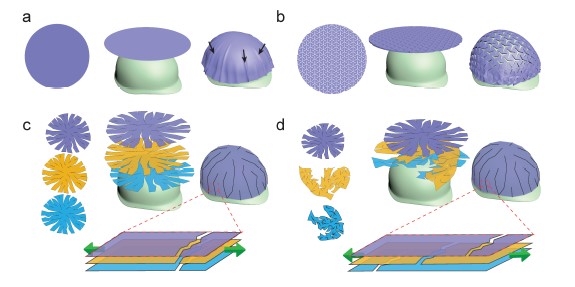A method for fabricating stronger 3D curved surfaces by stacking multiple layers of 2D sheets, each having a specified cutting pattern, into one composite material
Problem:
Morphing flat sheets into three-dimensional (3D) curved surfaces has recently attracted significant attention in diverse applications such as soft robotics, architectural structures, and biomedical devices. Current approaches to create structures with desired curved surface often relies on soft and stretchable materials or by introduced cuts, which weaken the mechanical properties. More specifically, the ability to achieve high mechanical strength and 3D curvatures has not yet been demonstrated.
Solution:
This method uses an optimized cutting approach to transform multiple two-dimensional (2D) composite plies into a 3D curved stacked surface. This surface is able to conform to complex shapes of arbitrary curvatures while maintaining lightweight and high mechanical strength.
Technology:
In traditional approaches, multiple cuts are necessary in order to transform a 2D sheet into a curved surface. However, each cut weakens the overall strength of the structure. This approach calculates pathways to cut and unfold a 3D curved surface from multiple 2D sheets while avoiding overlapping cuts on adjacent layers. This results in a strong, lightweight optimized structure with no self-overlapping.
Advantages:
- Multi-layered structure designed with this approach withstood 40% larger load forces when compared to a randomized cutting scheme
- Can be used to conform to complicated surfaces without any folds or wrinkles
- All existing algorithms on unfolding polyhedral mesh can be easily integrated into this approach

The figure shows various approaches to conforming 2D sheets towards 3D curved surfaces. A) Wrapping a flat sheet results in wrinkles. B) Kirigami patterns can prevent wrinkles but small hinges and uncovered regions limit the strength. C) Computational wrapping algorithm provides full coverage but overlapping cuts weaken the strength of the structure. D) This new approach which avoids cuts overlapping at the same position upon stacking, thus increasing strength. Figure obtained from the paper “Morphing flat sheets to 3D curved surfaces with optimized mechanical performance.”
Stage of Development:
- Bench Prototype
- Minimum Viable Product
Case ID:
22-9934-tpNCS
Web Published:
5/12/2023
Patent Information:
| App Type |
Country |
Serial No. |
Patent No. |
File Date |
Issued Date |
Expire Date |